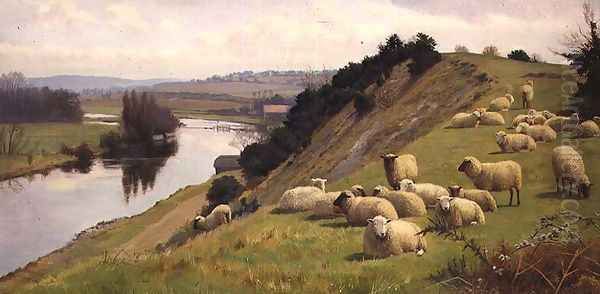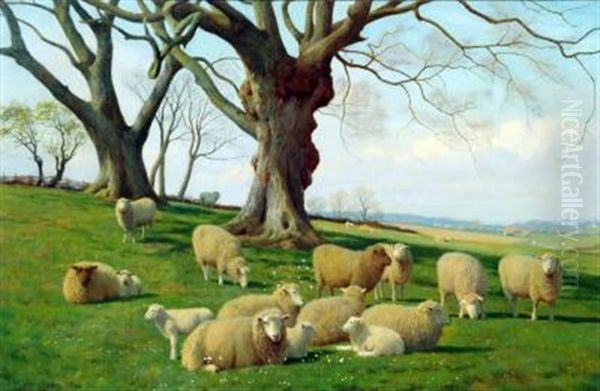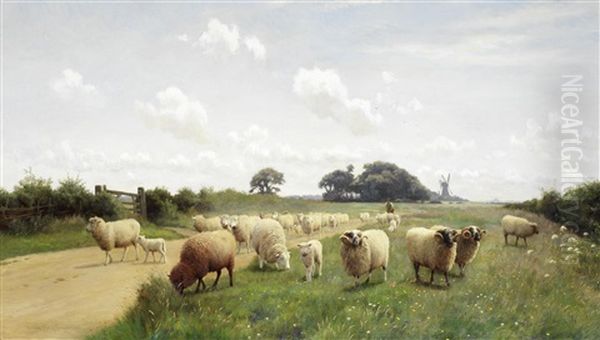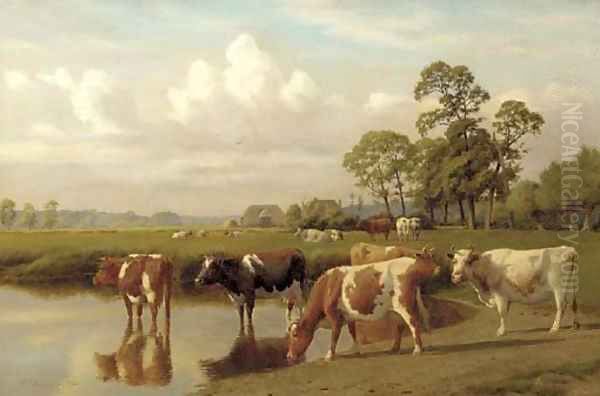William Sidney Cooper stands as a notable figure in the lineage of British landscape painting, an artist whose life and work were deeply intertwined with the rural charm of the Kentish countryside. Born in 1854 and passing away in 1927, Cooper dedicated his career to capturing the gentle beauty of pastoral scenes, particularly those featuring livestock, which became a hallmark of his artistic identity. His connection to one of the most celebrated animal painters of the Victorian era, Thomas Sidney Cooper, undoubtedly shaped his path, yet William carved his own niche, leaving behind a body of work appreciated for its sincerity and observational skill.
His era was one where landscape painting held significant sway in British art. The towering achievements of earlier masters like John Constable, with his revolutionary depictions of Suffolk, and J.M.W. Turner, whose atmospheric and often dramatic canvases pushed the boundaries of the genre, had laid a formidable groundwork. By the mid-19th century, when Cooper began his life, landscape and rural subjects were immensely popular, catering to a Victorian sensibility that often romanticized the countryside amidst rapid industrialization.
Early Life and Artistic Inheritance
William Sidney Cooper entered the world during a vibrant period for British art. His familial connection to the art world was significant; he was the nephew (sometimes cited as grand-nephew, highlighting the prominence of his relative) of Thomas Sidney Cooper (1803-1902). Thomas, often affectionately nicknamed "Cow Cooper," was a towering figure, renowned particularly for his masterful paintings of cattle and sheep, often set within idyllic Kent landscapes. This family tie provided William not only with potential inspiration but also placed him within an established artistic tradition.

Growing up under the influence of such a successful relative likely steered William towards similar artistic pursuits. The elder Cooper's meticulous attention to animal anatomy and his ability to capture the tranquil atmosphere of the Canterbury environs set a high standard. While details of William's earliest training are not extensively documented, it's known he studied art, likely benefiting from the resources and connections available through his family, possibly including time at the Sidney Cooper School of Art in Canterbury, founded by his famous uncle.
The Victorian art scene itself was diverse. While Cooper would follow a more traditional path, movements like the Pre-Raphaelite Brotherhood, founded just a few years before his birth, were challenging academic conventions. Artists like Dante Gabriel Rossetti, John Everett Millais, and William Holman Hunt focused on intense detail, vibrant colour, and subjects drawn from literature and religion, representing a different artistic current from the pastoral landscape tradition Cooper would embrace.
Development of Style: Landscape and Livestock
William Sidney Cooper developed a style characterized by careful observation, a gentle realism, and a clear affection for his subjects. Like his uncle, he demonstrated a particular aptitude for depicting livestock, especially cattle and sheep. These animals were not mere accessories in his landscapes but often the central focus, rendered with an understanding of their form and behaviour. His proficiency in this area led some to refer to him, like his uncle, as "Cow Cooper," a testament to the shared thematic territory.
His preferred mediums were oil paint and watercolour, both handled with considerable skill. His oil paintings often possess a richness and depth, allowing for detailed rendering of animal hides, foliage, and the play of light across the fields. His watercolours showcase a lighter touch, effectively capturing the transient effects of weather and atmosphere inherent in the British landscape. He excelled at portraying the peaceful, bucolic aspects of rural life, often choosing scenes bathed in soft sunlight, emphasizing harmony between the animals and their environment.
His approach aligns with a significant stream of Victorian landscape painting that valued naturalism and detailed representation. While perhaps not as dramatic as Turner or as scientifically observant as Constable in his cloud studies, Cooper's work offered a comforting and accessible vision of the English countryside. His skill in animal painting can be considered alongside contemporaries like Sir Edwin Landseer, whose works, often imbued with narrative and anthropomorphism, were immensely popular, though Cooper's style generally remained more straightforwardly pastoral.
The Herne Bay Focus

A pivotal moment in Cooper's life and career occurred around the age of forty when he made the decision to move permanently to Herne Bay in Kent. This coastal town and its surrounding countryside became the primary inspiration for the remainder of his artistic output. This deep connection to a specific locale allowed him to develop an intimate knowledge of its features, its changing seasons, and its characteristic light.
His paintings from this period frequently depict the rolling fields, gentle slopes, and meandering pathways typical of the Kentish landscape near Herne Bay. Cattle grazing peacefully, flocks of sheep dotting the hillsides, or resting beneath trees became recurring motifs. He captured the specific textures of the region – the chalky cliffs, the lush pastures, the particular quality of the light filtered through the coastal air. This dedication to a specific region echoes the practice of many landscape painters, such as George Vicat Cole, known for his detailed views of Surrey, or Benjamin Williams Leader, another highly successful Victorian landscapist who often depicted scenes in Worcestershire and Wales.
Cooper's Herne Bay works convey a sense of tranquility and timelessness. They reflect a deep appreciation for the rhythms of rural life and the enduring beauty of the natural world. His commitment to this area resulted in a cohesive body of work that serves as a visual record of this part of Kent during the late 19th and early 20th centuries.
Representative Works and Collections
Several specific works exemplify William Sidney Cooper's style and subject matter. Paintings titled simply Sheep or Sheep in the Woods are indicative of his focus. One notable example, Sheep, is held in the collection of the Bedford Fine Art Gallery. Another work often cited is Sheep and Lambs, which specifically depicts these animals on the cliff tops near Herne Bay, showcasing his ability to integrate his favoured animal subjects within a specific, identifiable landscape setting.
An oil painting titled Shepherd and Sheep captures a quintessential pastoral scene, likely depicting a shepherd with his flock along a country lane. Beyond these specific titles, his large canvases featuring cattle were particularly noted and were exhibited prominently, for instance, in the Garden Room of The Beaney House of Art & Knowledge in Canterbury. This institution, located in the heart of the region both he and his uncle painted, holds works that attest to his local significance.

These representative works highlight his consistent themes: the gentle depiction of domestic animals, particularly sheep and cattle, within serene Kentish landscapes. The compositions are typically balanced and harmonious, emphasizing the peaceful coexistence of animals and nature. The recurring presence of his works in public collections, albeit perhaps not as widespread as his uncle's, confirms their recognized quality and historical value.
Exhibitions and Recognition
Throughout his career, William Sidney Cooper achieved a respectable level of recognition within the established art institutions of his time. He exhibited his works at prestigious venues, including the Royal Academy of Arts (RA) in London, the Royal Society of British Artists (RBA), and the Royal Watercolour Society (RWS). Inclusion in the exhibitions of these societies was crucial for an artist's visibility and professional standing during the Victorian and Edwardian periods.
Exhibiting at the Royal Academy, in particular, placed an artist's work before a large and influential audience, including potential patrons and critics. While Cooper may not have achieved the full membership status (RA) that his uncle enjoyed, his regular acceptance into these exhibitions signifies that his work met the standards of the selection committees and found favour with the public. He operated within the mainstream of British art, alongside numerous other landscape and animal painters vying for attention.
His success is often described as "moderate," particularly when measured against the fame of Thomas Sidney Cooper. However, maintaining a consistent presence at these major London exhibitions over several decades was a significant achievement in a competitive art world populated by figures like the President of the Royal Academy, Frederic Leighton, or the highly popular classical painter Lawrence Alma-Tadema, whose works often dominated the Academy's walls. Cooper's steady output and exhibition record demonstrate a dedicated professional career.
The Cooper Artistic Legacy
The relationship between William Sidney Cooper and his uncle, Thomas Sidney Cooper, is central to understanding William's place in art history. He clearly inherited and continued the family's artistic focus on pastoral landscapes and livestock, particularly the cattle and sheep that had brought his uncle such renown. The shared nickname "Cow Cooper" underscores this thematic continuity. William learned from his uncle's example, adopting a similar commitment to careful observation and realistic rendering.

However, there were also differences, primarily in the scale of their success and recognition. Thomas Sidney Cooper became one of the wealthiest and most famous artists of his generation, his works collected by aristocracy and industrialists, and prominently displayed in national collections like the Tate Gallery and the Victoria and Albert Museum. He achieved the distinction of becoming a Royal Academician (RA). William, while respected, operated on a somewhat quieter level, his reputation more solidly rooted in Kent and among admirers of traditional pastoral painting.
The Cooper family's artistic inclinations extended further, with Thomas Sidney Cooper's son, Thomas George Cooper (1835-1901), also pursuing a career as a painter, often working in watercolour and focusing on similar rural subjects. This creates a picture of a multi-generational artistic dynasty centred around Canterbury and the depiction of its surrounding countryside, with William Sidney Cooper playing a distinct role within that lineage.
Context: Victorian Animal and Landscape Painting
William Sidney Cooper worked during a period when both landscape and animal painting enjoyed immense popularity in Britain. The Victorian era saw a burgeoning middle class with the means and desire to acquire art, and familiar, reassuring scenes of the countryside held great appeal. This was partly a reaction against the increasing urbanization and industrialization of the country, with pastoral art offering an idealized escape.
Animal painting, in particular, flourished. Artists like Sir Edwin Landseer achieved celebrity status with works that often told stories or evoked strong emotions. Briton Rivière, another prominent artist, was known for his often dramatic paintings featuring animals, sometimes in historical or mythological settings. Cooper's work, generally calmer and less narrative-driven, represented a different facet of this interest, focusing on the quiet dignity of farm animals within their natural environment.
The detailed, realistic style favoured by Cooper and his uncle was characteristic of much mainstream Victorian art. It catered to a taste for verisimilitude and craftsmanship. While avant-garde movements were developing elsewhere in Europe, and Impressionism was beginning to make its mark, the established taste in Britain, particularly for landscape and animal subjects, often remained rooted in careful observation and detailed finish well into the late 19th century.
Later Life and Enduring Contribution
William Sidney Cooper continued to paint in and around Herne Bay throughout his later years, remaining dedicated to the subjects and style he had mastered. He passed away in 1927, bringing to a close a long career spent chronicling the gentle landscapes of Kent. By this time, the art world was undergoing profound changes. Post-Impressionism, Fauvism, and Cubism had revolutionized painting on the continent, and British art was also evolving with the emergence of groups like the Camden Town Group, featuring artists such as Walter Sickert and Philip Wilson Steer, who explored more modern approaches to urban life and landscape.
Despite these shifts in artistic fashion, Cooper's work retains its value as a sincere and skilled representation of a specific time and place. His paintings offer a window into the rural England of the late Victorian and Edwardian periods, captured with an artist's eye for detail and a palpable affection for the pastoral way of life. His contribution lies not in radical innovation, but in the consistent quality and dedication he brought to his chosen genre.
His legacy is primarily that of a talented landscape and animal painter, firmly rooted in the Victorian tradition. He successfully navigated the London art scene, exhibiting regularly at major institutions, and became particularly associated with the depiction of the Herne Bay area. While often viewed in relation to his more famous uncle, William Sidney Cooper's body of work stands on its own merits, appreciated for its peaceful atmosphere, technical competence, and faithful portrayal of the English countryside.
Conclusion: A Chronicler of Kentish Charm
William Sidney Cooper (1854-1927) occupies a specific and respectable place within the history of British art. As the nephew of the celebrated Thomas Sidney Cooper, he inherited a strong tradition of animal and landscape painting, which he adapted with his own sensibility. His career, marked by consistent exhibition at London's premier art societies, was centred around his deep connection to the Kentish countryside, particularly the area around Herne Bay where he settled later in life.
Specializing in oil and watercolour depictions of pastoral scenes, often featuring cattle and sheep rendered with sympathetic detail, Cooper captured the tranquil beauty of rural England. Works like Sheep, Sheep and Lambs, and his notable cattle paintings exemplify his skill and thematic focus. Though perhaps overshadowed by his uncle's fame and operating within a more traditional vein compared to emerging modernist trends, his "moderate success" reflects a solid career built on technical skill and a genuine love for his subject matter.
His paintings remain appealing for their peacefulness and their detailed observation of nature. They serve as valuable documents of the Kent landscape during his time and stand as a testament to the enduring appeal of the pastoral genre in British art. William Sidney Cooper endures as a dedicated chronicler of the fields, farms, and fauna of his beloved Kent.